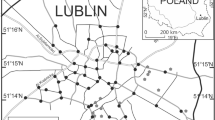Abstract
The aim of this study was to assess the heavy metal content of the dust generated by the Sagamu cement factory and its attendant health hazards on the immediate environment, especially on the inhabitants of the area. A total of 25 samples were collected and analyzed using inductively coupled plasma-optical emission spectrometry. Records of medical ailments associated with heavy metal toxicity were also compiled from the Obafemi Awolowo Teaching Hospital situated in the town.The results for some of the selected heavy metals showed the following pattern: limestone: Cd (n.d.-1.7 ppm), Pb (42–48 ppm), Cu (3.0–11 ppm), Zn (7.0–53 ppm) and Ni (3.0–8.0 ppm); shale: Cd (0.3–1.1 ppm), Pb (17–22 ppm), Cu (2.0–11 ppm), Zn (17–147 ppm) and Ni (3.0–18 ppm); dusts: Cd (0.5–0.7 ppm), Pb (32–52 ppm), Cu (2–16 ppm), Zn (5–152 ppm) and Ni (2–17 ppm); soils: Cd (0.5–1.1 ppm), Pb (28–49 ppm), Cu (22–35 ppm), Zn (43–69 ppm) and Ni (13.0–17 ppm). High levels of heavy metals were found in the rocks and soils. We propose that the high levels of metals in the dust and soil were acquired from the raw materials used by the cement factory and from active industrial discharge from this same factory. Medical records and the current health situation of the local residents in the study area reveal that there have been increases in the prevalence of diseases linked to heavy metal toxicity in the environment, especially those related to dust generation.



Similar content being viewed by others
References
Adegoke, O. S. (1969). Eocene stratigraphy of southwestern Nigeria. Mineral Memoir, 69, 23–46.
Adegoke, O. S., & Omatsola, M. E. (1981). Tectonic evolution and Cretaceous stratigraphy of the Dahomey Basin. Journal Mining and Geology, 8(1), 130–136.
Agagu, O. K. (1985). A geological guide to bituminous sediments of southwestern Nigeria.Unpublished report of Department of Geology, Ibadan: University of Ibadan, 16.
Appleton, J. D., Fuge, R., & McCall, G. J. H. (1996). Environmental geochemistry and health with special reference to developing countries. Geological Society Special Publication No.113, 37 pp.
Bowie, S. H. U., & Thornton, I. (1985). Environmental geochemistry and health. Lancaster: D Reidel Publishing Company, 140.
Fergusson, J. E. (1990). The heavy elements. Chemistry, environmental impacts and health effects. Oxford: Pergamon Press, 614.
Fordyce, F. M., Plant, J., Smith, B., Appleton, D., Johnson, S. P., & Williams, L. (1999). Environmental geochemistry and health - Global Perspectives. In: Proceedings of ICSU-IGU workshop on setting an agenda on health and the environment. (pp. 1–13) Health and Environmental Resources, Mona, Jamaica (Nov. 12–14, 1999).
Jones, H. A., & Hockey, R. O. (1964). The geology of part of southwestern Nigeria. Geological Survey of Nigeria Bulletin, 13, 56–77.
Krauskpof, K. B. (1967). Introduction to Geochemistry. New York: McGraw-Hill, 721.
Lag, J. (1989). Excess and deficiency of trace elements in relation to human and animal health in arctic and subarctic regions. Norwegian Academy of Science Letters, 3–15.
Nriagu, J. O. (1981). Cadmium in the Environment. Part II: Health Effects. New York: Wiley, 584.
Rose, A. W., Hawkes, E. H., & Webb, J. S. (1979). Geochemistry in mineral Exploration (2nd ed.). London: Academic Press, 657.
Sharma, R. K., & Sharma, U. (1997). Physiological perspectives of Copper. Report of Department of Zoology, India: Kunishetra University, 698–713.
Thornton, I. (1986). Geochemistry and health. In: Proceedings of the 1st symposium on geochemistry and health. Northwood: Science Reviews Ltd, 1–3.
Thornton, I. (1988). Geochemistry and health. In: Proceedings of the 2nd symposium on geochemistry and health. Northwood: Science Reviews Ltd, 1–2.
Xiu, Y. M. (1996). Trace elements in health and diseases. Biomedical and Environmental Sciences. Department of Trace Element Nutrition. Chinese Academy of Preventive Medicine, China: Beijing, 130–136.
Author information
Authors and Affiliations
Corresponding author
Rights and permissions
About this article
Cite this article
Abimbola, A.F., Kehinde-Phillips, O.O. & Olatunji, A.S. The Sagamu cement factory, SW Nigeria: Is the dust generated a potential health hazard?. Environ Geochem Health 29, 163–167 (2007). https://doi.org/10.1007/s10653-006-9068-7
Published:
Issue Date:
DOI: https://doi.org/10.1007/s10653-006-9068-7




